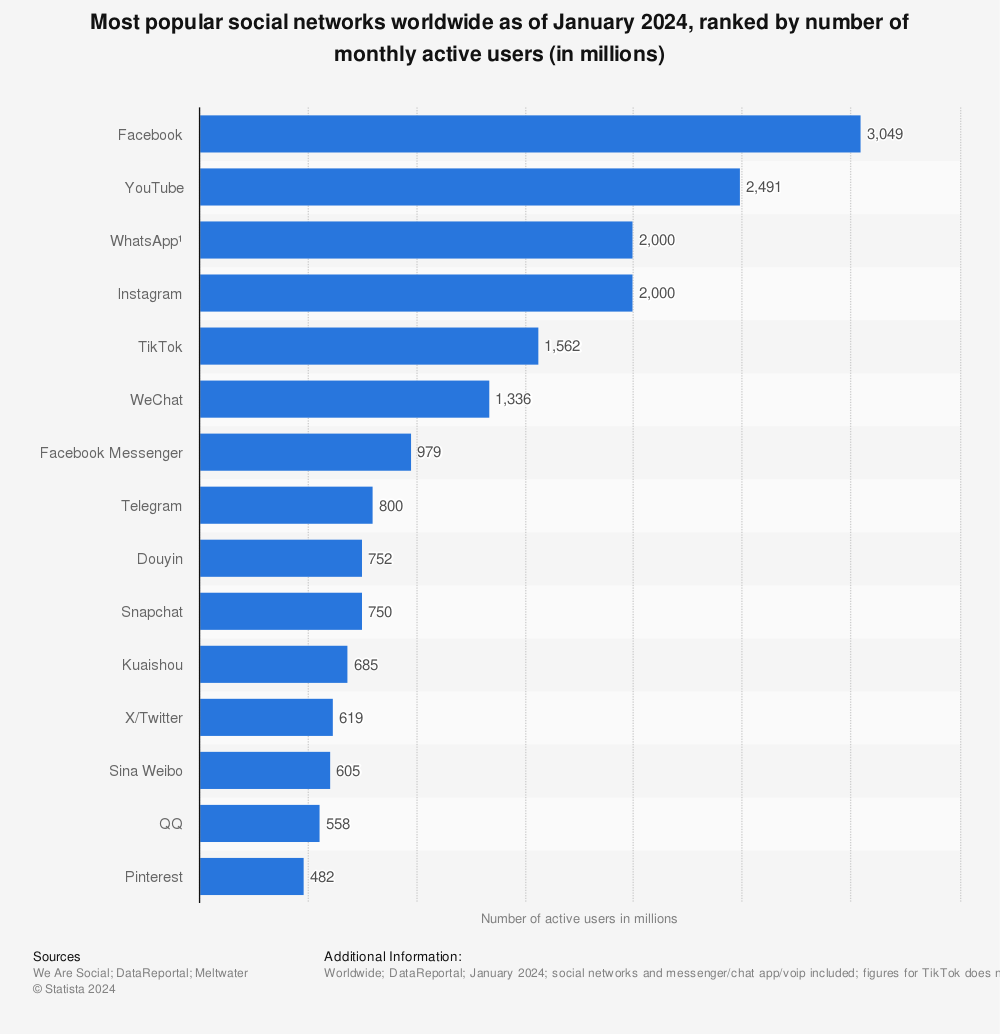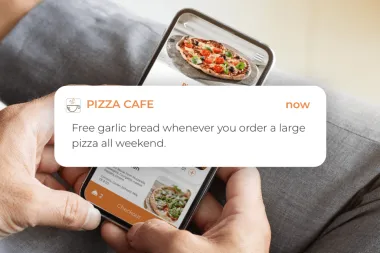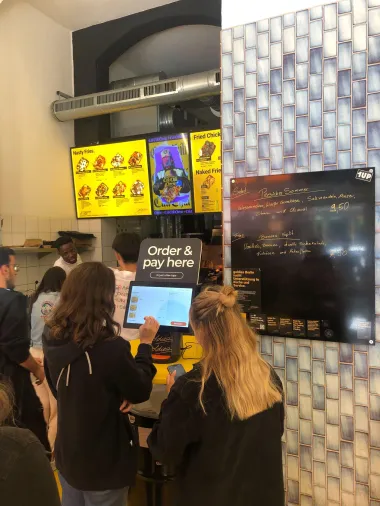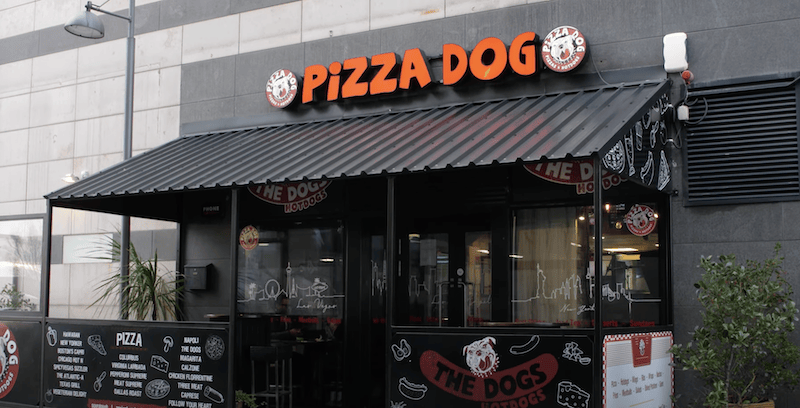Restaurant marketing is one of those areas of running your business that’s easy to neglect despite its massive importance. Here we’ll break down the fundamentals of restaurant marketing, discuss its importance and offer practical tips and tactics to attract more customers and boost your sales.
Online sales for the food and beverage industry are still on the up, growing faster than industries like fashion and retail which were earlier digital adopters. According to ecommerce experts Common Thread, global F&B ecommerce sales are up 16.3% YOY to $506 billion. And the market is set to expand another 19.2% to $857 billion by 2025.
These statistics point to a huge opportunity in driving customers to your digital sales channels, like online ordering websites and mobile apps.
Below we discuss a number of approaches to restaurant marketing including the fundamentals of creating a marketing budget and calculating ROI, to exploring different ways to market your restaurant with fresh restaurant marketing ideas.
What is restaurant marketing?
Restaurant marketing is the effort to present your quick service restaurant, fast casual restaurant or takeaway business to the world. It includes showcasing your brand, products and offerings to the general public to achieve greater brand awareness, increase sales and grow your business.
Some business owners manage their own restaurant marketing as they are the most involved with growing their brand. Other businesses employ marketing managers or sometimes assign the responsibility to a staff member, while some hire a freelancer or an external restaurant marketing agency.
Restaurant marketing isn’t always an exact science. It requires a lot of trial and error, A/B testing and data analysis. When a project goes wrong or doesn’t return the expected results, it’s important to always know why it happened. Through continuous improvement, you can fine-tune your restaurant marketing to work for both your business and your ideal target market.
Although dropping menus through doors and in-store marketing are still effective strategies, most restaurants are trying to attract online searchers. Digital marketing for restaurants is any marketing that involves digital technology, like social media, emails, SMS messages, online marketing and in-store marketing on your POS system.

Why is restaurant marketing important?
Restaurant marketing covers a broad range of tactics that you can tailor to your own specific budget.
Think of it this way. You’ve worked so hard to build your business and have the best products around, now you need to make sure that your customers continue to come back, while also attracting new customers to grow in-store orders at your restaurant. This is why restaurant marketing is so important.
The restaurant industry is incredibly competitive. Marketing your restaurant helps you stand out from your competitors, but it also builds relationships with your customers to grow customer loyalty.
From choosing a memorable restaurant name to driving online orders with targeted campaigns, a strong marketing strategy can be the difference between a flash-in-the-pan concept and a successful long-term restaurant brand.
Your marketing efforts might cost some money and expend resources, but the benefits will compound over time to:
Attract a steady flow of new customers
Showcase your values, mission and vision for the future
Build your restaurant brand and reputation
Boost loyalty, keeping orders and giving you brand ambassadors spreading the word to new customers
Attract quality team members with the same values
Build connections in the local community
Over time, all of these benefits feed into each other giving you a massive ongoing payback on your initial investment.
What are the different ways to market your restaurant
With technology like the internet and smartphones commonplace, a whole new range of restaurant marketing tactics has become available. While digital marketing can be very effective at driving new business to your online channels, you may find that more traditional offline strategies work best for your restaurant.
Let's take a look at nine ways to market your restaurant, online and IRL.
1. Organic social media
Social media marketing has become a staple activity for restaurant and takeaway businesses. Literally, half the world is on social media. And nearly half of diners are influenced by social media, according to QSR Magazine.
Social media marketing for restaurants is an unmissable opportunity to engage with potential customers. Statista reports that, as of January 2022, Facebook has the largest user base among the global social media platforms with almost 3 billion monthly active users. Youtube isn’t far behind with 2.5 billion and Instagram, which is particularly popular among foodies, has nearly 1.5 billion.
TikTok trails slightly with 1 billion monthly active users but is still growing rapidly.

TikTok marketing is growing in popularity among restaurant operators for its potential to connect with upcoming generations and the huge opportunity in influencer marketing.
Below is an example of an influencer posting a video about Patisserie Valerie on TikTok.
@the2halalfoodies Loved the mint hot chocolate #patisserievalerie #afternoontea #london #cafe #hotchocolate #fyp ♬ Calm Down - Rema & Selena Gomez
2. Restaurant advertising on social media
In comparison to traditional leafleting and print advertising, social advertising is relatively low-cost and can work with small budgets. It is also one of the most popular forms of advertising for restaurants and takeaways, and should certainly be considered as part of your restaurant social media strategy.
Many restaurants advertise on Facebook and Instagram to attract a specific audience. With a restaurant Instagram post, for example, you can target specific locations and age groups, switch ads on and off depending on the length of your campaign, and analyse data to make sure they continue working well for your business.
3. Google Ads
Google ads are paid placements in search engine results and across Google’s network of display ads on websites that host them.
Google is the top search tool for people looking for restaurants, with 69% using Google to find local business information. And Google Ads offer the quickest way to jump to the top of the search results, which is as far as most searchers get to.

If you’re not protecting your brand with Google Ads, it’s likely that your competitors, including delivery marketplaces, are attempting to capture customers who are searching for your restaurant. Beyond that, Google Ads are a great way to attract new customers that are searching for food in your area.
4. TV
When people think of marketing, many first thoughts are of TV ads. This form of advertising is one of the most expensive forms of advertising — both the production and the media buying.
The price of media buying varies wildly, depending on the channel, reach and time slot. Local networks offer better value for small businesses, while franchises and chains may plump for air time on national or international cable, satellite or terrestrial channels.
Though being able to run your ads on TV is great for brand awareness, you don’t get detailed data of what target audience has seen your ad. Online TV players can offer better stats, but again, can be costly, and as such is more suitable for larger operations.
5. Email marketing
Email marketing is a great way to connect with your customers, as you can send updates with more than one piece of information. Your email can contain news updates from your business, information on new menu items, plus deals and promotions, all in one place. It is a great tool to build relationships with your customers, and can be as complex or simple as you want it to be.
6. SMS marketing
SMS marketing, also known as text message marketing, is the process of sending promotional text messages to your customers to alert them to relevant news relating to your business. SMS marketing for restaurants is key in any successful restaurant marketing strategy.
Loyalty campaigns build order frequency, which fosters routine customer habits and stronger relationships. Flipdish data shows for every dollar spent on loyalty, there is $11 in return and customers who use loyalty spend 5x more than those who don’t.
These updates should be short and to the point, as there is a character limit of 160 characters per message. As well as this, SMS messages are a very personal and direct way to reach your customers. Every update should bring value to your customers and watch you don’t over-communicate as it can trigger them to unsubscribe.

7. Word of mouth
This is possibly the most valuable form of marketing for your business. Word of mouth is when your customers love your business so much that they become advocates for you, and recommend your products or services to their friends and family.
These advocates of your business provide you with the best advertisement possible, as their friends and family members will trust their advice. The fact that they have experienced your business and are willing to recommend it to their loved ones is a powerful endorsement.
8. Direct Mail
Direct mail is the sending of physical marketing materials to your customers. These can be letters, leaflets and/or copies of your menu. Many business owners rely on direct mail as a primary tool of their restaurant marketing strategy.
It's one of the most effective marketing ideas for pizza restaurants, as it ensures a potential customer has your menu handy when they want to order a pizza for delivery.
However, if you have many marketing efforts running at the same time, it is difficult to track the results of direct mail. As well as this, it can be expensive to print and distribute such marketing materials.
9. In-store marketing
Once customers have entered your premises, it’s likely they’re already planning on making a purchase. So in-store marketing is more about making the process as easy as possible, encouraging them to spend more and boosting the chance that they will recommend your restaurant and return to make a repeat purchase.
In-store marketing involves measures like:
Improving your digital menu boards and signage to make ordering easier
Implementing technology like self-service kiosks to reduce wait times and increase average order value
Providing flyers and cards with details of how your customers can order online

How to create an effective restaurant marketing strategy
1. Set a budget
Some people think it can be easier to set your budget after brainstorming restaurant marketing ideas, however this can create a problem where you have a seemingly perfect plan but not the resources to execute it so perfectly. Assign your budget in advance of creating your marketing plan so that your ideas are realistic and achievable.
A good starting point when it comes to setting your restaurant marketing budget is to consider your top line revenue and then multiply it by 3%. Remember, this is a guide and not a strict rule, so adjust your budget accordingly.
2. Set realistic goals
In order to create the perfect marketing plan for your business, take some time to assess where your business is right now, and look at where you want it to be by the end of the campaign, or by the end of the quarter.
Consider what your objectives are. Do you want to attract new customers? Retain your current customers? Increase online orders? Or maybe increase your average order value?
Outline your objectives and create a specific strategy around each one. A good idea would be to focus on one objective at a time so that you can put maximum effort into each project.
Once you have chosen your objectives you can go about setting your goals. Each goal should be SMART, that is to say Specific, Measurable, Attainable, Relevant, and Timely.
If your objective is to retain your current customers, an example of a SMART goal would be to create a customer loyalty programme that would be used by 100 customers in one month.
Specific
This is a direct, specific action.
Measurable
This goal has given itself the task of acquiring a particular number of users.
Attainable
You have it within your budget or technology to create your own customer loyalty programme.
Relevant
This goal is relevant to your business and is something that the industry uses to complete your objective.
Timely
You have set a time in which you will achieve your goal.
3. Find your ideal customers
In order to ensure your campaign reaches the right audience, you need to know who your target audience is. Who are you trying to reach with your campaign? Why would they want what you have to offer?
Creating buyer personas can help you better understand who your target audience is and help you use the correct design and information to appeal to them.
To do this, think of your ideal customer, their age, gender, industry, location, and interests. You may have numerous personas. Now, name them. From this, you can determine what you need to do to attract them. Naming your personas helps you connect directly to your target audience’s needs. You can continually ask yourself questions like, “Would Ruth rate this?”
4. Understand what makes you unique
When you first opened your business, you knew you had something different to offer. Has this changed? Think about what keeps your customers coming back to you, and how your product or service makes them feel.
Whatever that special thing is, your USP, you need to harness this in your restaurant marketing strategy and consider how you are going to use this to appeal to your customers. Surveying or polling your customers in real-life or on social media can be useful to gauge sentiment.

5. Choose your channels
Now you know who you want to target and you know what unique value you bring, it’s time to consider which channels you are going to use.
Make sure to choose the channels that your ideal customers are using to ensure you don’t waste time and resources creating content or graphics for channels that won’t achieve your objectives.
For example, if you are trying to appeal to people who are over the age of 50, look to the relevant data. According to research from drop shipping tool Oberlo, just 4% of Snapchat users are 50+. So there would be a lot of wastage if you were to have Snapchat as a key tool for this campaign. At the same time, use of Facebook by older generations is rising rapidly. Be clever about where to target your restaurant marketing and your efforts will be rewarded.
6. Measure and track using analytics
Now that you have launched your campaign, it is important to ensure that everything is working according to plan.
Look at the different channels you are using to execute the plan, and ensure that you check the results in the analytics dashboard daily to monitor the success of your campaign. This will ensure that you can adjust any strategies that aren’t working for you and guarantees that you don’t end up with any surprise bills at the end of your campaign.
7. Reflect and improve
Regardless of how much time you spend on your campaign, there are always going to be things that don’t work as well as you hoped or little surprises in what actually works for your business.
Spend some time thinking of what worked well for you as well as what needs improving, and keep these learnings in mind when you are next brainstorming your restaurant marketing ideas.
How to create a restaurant marketing budget
Your marketing budget will depend on a number of factors, and is ultimately an adjustable choice you can make depending on your needs. There are two popular rules for determining what your restaurant marketing budget should be, and how you should spend it.
The 3-6% rule
Take a look at your overall sales, and then multiply it by 3% up to 6%. This is often used as a starting point for how much you should be spending on your restaurant marketing budget.
Remember, this is a guideline. Allow yourself to make changes to your marketing budget, if you feel it’s necessary. For example, if the opportunity arises to do a PR campaign and you feel that the results will outweigh the short jump in expenditure then that is your prerogative. However, be wary of making continuous financial changes to your budget as you may find it easier to overspend.
The 70/10/20 rule
When it comes to dividing your budget into different areas, the 70/10/20 rule is a useful guideline.
According to this rule, 70% of your restaurant marketing budget should be spent on campaigns that have been successful in the past. These are strategies that you know have worked in the past and are almost guaranteed to help your business.
10% of your budget should be spent on experimental strategies that you haven’t tried before. Have a look around and see what others are doing in the industry, and in other areas or countries, that you think could work for you. Then choose whatever you feel you have the time and resources to attempt. You may be surprised.
The final 20% of your budget would then be spent on improving and developing on last week’s, month’s or quarter’s experimental tactics. Take time to look at what worked for you, what you took a bit of a gamble on, and make it even better this time.

Calculating your restaurant marketing ROI
When it comes to calculating the return on your investment for your marketing strategy, there is a commonly-used and simple formula to help you understand just how much your restaurant marketing campaign actually benefited your restaurant financially.
To try it, divide your gross profit by your marketing expenses. As an example, let’s say this value works out to 500%, then you know that every dollar spent on your restaurant marketing campaign generated you $5 in profit. As a benchmark, our team of restaurant marketing experts at Flipdish secure an average ROI of 533% across all cuisine types.
Remember, there are benefits of restaurant marketing campaigns that aren’t easy to calculate return financially. For example, brand awareness campaigns don’t usually generate immediate ROI but will help your restaurant grow in the long-term.
If you really want to maximise ROI on your marketing campaigns, find a restaurant marketing agency that knows the industry inside-out and that can prove that your investment in marketing is producing tangible results.
Get control of your restaurant marketing for the best chance of success
Restaurant marketing can seem like a minefield for some restaurant owners, and it's easy to get overwhelmed by the range of advice offered on the topic.
But by staying true to your restaurant's unique selling points, being clear on your objectives and setting SMART goals, you are likely to see some amazing results. And remember, if something doesn't work, you can learn from it and improve your strategy until you find success.
Hopefully, this guide will provide the inspiration and tactics you need to give your campaigns the best chance of success. And keep those customers coming back to your restaurant time and time again.


